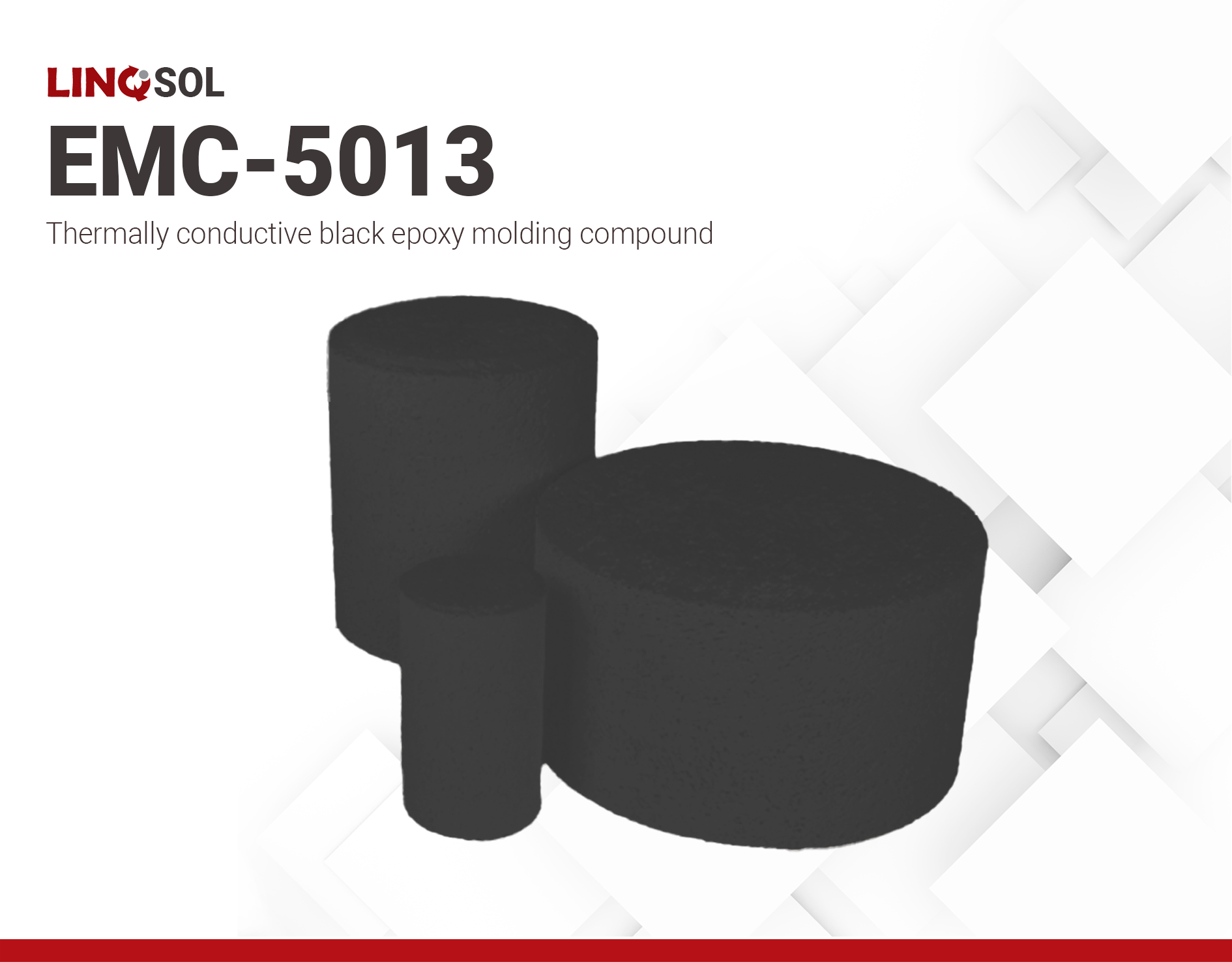LINQSOL EMC-5013 | Thermally conductive Epoxy Mold Compound
- Green epoxy molding compound
- Thermally conductive molding compound
- Designed for transistor outline (TO) and fullpack power packages
Product Description
LINQSOL EMC-5013 is a thermally conductive epoxy molding compound specifically developed for the encapsulation of transistor outline (TO) such as TO220F, TO3PF and fullpack packages power packages. Its low porosity and thermal conductivity of >2 W/m·K satisfies the heat dissipation required by high performance power packages.
LINQSOL EMC-5013 has good electrical performance for packages requiring insulative property. Additionally, with a UL 94 V-0 flammability rating and low water absorption, EMC-5013 guarantees strong performance and outstanding reliability. This product is deliberately formulated without the inclusion of substances prohibited by the European Union RoHS and REACH. Overall, LINQSOL EMC-5013 seamlessly integrates advanced material properties, safety compliance, and superior performance to deliver a reliable solution for semiconductor device encapsulation.
Technical Specifications
| General Properties | |
| Color Color The color | Black |
| Specific Gravity Specific Gravity Specific gravity (SG) is the ratio of the density of a substance to the density of a reference substance; equivalently, it is the ratio of the mass of a substance to the mass of a reference substance for the same given volume. For liquids, the reference substance is almost always water (1), while for gases, it is air (1.18) at room temperature. Specific gravity is unitless. | 2.17 |
| Thermal Properties | |
| Glass Transition Temperature (Tg) Glass Transition Temperature (Tg) The glass transition temperature for organic adhesives is a temperature region where the polymers change from glassy and brittle to soft and rubbery. Increasing the temperature further continues the softening process as the viscosity drops too. Temperatures between the glass transition temperature and below the decomposition point of the adhesive are the best region for bonding. The glass-transition temperature Tg of a material characterizes the range of temperatures over which this glass transition occurs. | 178 °C |
| Thermal Conductivity Thermal Conductivity Thermal conductivity describes the ability of a material to conduct heat. It is required by power packages in order to dissipate heat and maintain stable electrical performance. Thermal conductivity units are [W/(m K)] in the SI system and [Btu/(hr ft °F)] in the Imperial system. | 2.3 W/m.K |
| UL 94 Rating UL 94 Rating Flammability rating classification. It determines how fast a material burns or extinguishes once it is ignited. HB: slow burning on a horizontal specimen; burning rate less than 76 mm/min for thickness less than 3 mm or burning stops before 100 mm V-2: burning stops within 30 seconds on a vertical specimen; drips of flaming particles are allowed. V-1: burning stops within 30 seconds on a vertical specimen; drips of particles allowed as long as they are not inflamed. V-0: burning stops within 10 seconds on a vertical specimen; drips of particles allowed as long as they are not inflamed. 5VB: burning stops within 60 seconds on a vertical specimen; no drips allowed; plaque specimens may develop a hole. 5VA: burning stops within 60 seconds on a vertical specimen; no drips allowed; plaque specimens may not develop a hole | V-0 |
| Electrical Properties | |
| Volume Resistivity Volume Resistivity Volume resistivity, also called volume resistance, bulk resistance or bulk resistivity is a thickness dependent measurement of the resistivity of a material perpendicular to the plane of the surface. | 7.0x1015 Ohms⋅cm |
| Chemical Properties | |
| Moisture absorption | 0.32 % |
| Curing Conditions | |
| Transfer Pressure | 40-90 kg/cm2 |
| Transfer Time | 17-25 s |
| Physical Properties | |
| Spiral Flow @ 175°C | 60 cm |
Additional Information
Property | Value | Unit |
General Properties | ||
Resin type | OCN/Low Stress | – |
Filler sieving size | 180 | µm |
Specific gravity | 2.17 | – |
Spiral flow at 175°C | 60 | cm |
Bleed Length at 175°C | ≤2.0 | mm |
Chemical Properties | ||
Ion content Chloride (Cl–) concentration Sodium (Na+) concentration | 9 6 |
ppm |
Water absorption (PCT 24hr) | 0.32 | % |
pH of extract | 5.5 | – |
Electrical conductivity of extract | 40 | µS⋅cm–1 |
Electrical Properties | ||
Dielectric constant at 1MHz | 4.2 | - |
Dissipation factor at 1MHz | 0.009 | - |
Volume resistivity at 25°C | 7×1015 | Ω⋅cm |
Processing Instructions
Before use, let LINQSOL EMC-5013 compounds reach room temperature for 24 hours. Keep the bag unopened and stored in a dry location with a relative humidity of ≤50% during thawing to prevent moisture contamination.
Use the materials within 72 hours after removing the container from cold storage.
Storage and Handling
LINQSOL EMC-5013 is available in pressed pellets in a wide range of sizes to meet specific customer needs. To ensure product integrity, keep it away from oxidizing materials. For long-term storage, maintain a cold environment. The shelf life when stored below 5 °C is 183 days.
Please note that the provided information is based on available data and typical conditions. For specific applications and detailed test results, refer to the actual test data and conduct appropriate certifications.



